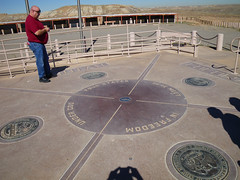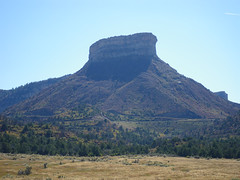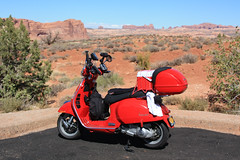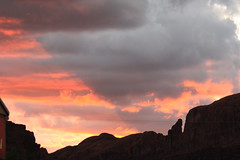Day Thirteen was primarily a travel day, getting from one side of the Navajo Reservation to the other. The main attractions of this day were to come in the afternoon, but not before the weather took a turn for the…unexpected.
Indian Country
Kayenta is at the far northern edge of Arizona, and my next destination was more towards the middle of the state. I had the choice of which route to take. The more direct route would have lead me through the heart of the Navajo Reservation towards Winslow, but I decided to take highways 160 and 89 into Flagstaff instead. Flagstaff is somewhat out of the way, but I decided to do this because of the condition of the roads on the reservation. They are okay for car travel, but they have a lot of breaks and repairs, which makes for a very bumpy ride on the Vespa.
Leaving Kayenta on Hwy 160, you pass Black Mesa on the left. Its called Black Mesa due to its abundant coal deposits, and I saw lots of evidence of coal mining along the way. By the way, traveling through this part of the country, it quickly becomes apparent that mining is a very important part of the economy here. It was the reason that this area was settled in the first place, because Lord knows that nothing much will grow around here.
Before too long, you come upon the Hopi Reservation, which is entire surrounded by the Navajo Res. Hwy 160 skirts the edge of the Hopi Res., so I didn’t see much of it, but I understand that the Hopi people have traditionally lived on a series of mesas—dubbed First, Second and Third Mesa by the Spanish—in the middle of their reservation. In contrast, the Navajo tend to live in small, isolated communities scattered throughout their much larger reservation. Interesting how two peoples who lived in such close proximity to one another developed such different social structures.
Just before hitting Hwy 89, you pass through a town called Tuba City, but there are no big brass instruments that I saw. The town, though apparently on Navajo territory, is named after a locally famous, nineteenth century Hopi chief named Tuuvi. A road from Tuba City leads into the heart of the Hopi Res., and to the largest town on the res., Second Mesa. There is a beautiful new “Travel Plaza” there, which is intended to entice visitors into “Hopiland.”
Travel plazas are something that we don’t have in Oregon and Washington, at least not on the same scale. I’ve noticed these things all over the Southwest. The area is sparsely populated and the towns tend to be widely spaced apart. In each of these little towns, there now appear to be these “travel plazas” which look like they have mainly replaced a number of older businesses. A travel plaza is usually a single business which combines a gas station, a convenience store, a gift shop, and one or more fast food outlets, all under the same roof. The idea is that you stop for gas at one of these places, and you can attend to all of your roadside needs at a single location. I’ve see these plazas with McDonalds, Taco Time, A&W and a host of other franchise brands. Usually these are “express” versions of the franchise, with only a small counter and a truncated menu. It takes a little getting used to, but it seems to make a lot of sense.
Flagstaff
You leave behind the Navajo Reservation about 50 miles north of Flagstaff. As you approach Flagstaff from the north on Hwy 89, the San Francisco mountain range looms into view. Flagstaff is on the other side of the range. about 25-30 miles north of Flag, I started running into a very heavy headwind directly from out of the south. This made the going very slow, because in addition to having to fight the wind, I was also gaining altitude into order to go over the San Francisco range. At times I could only muster 40 MPH on a highway were the speed limit was 65. I learned later that the wind was the forerunner of a big storm that was brewing out off the Pacific coast of Mexico, in combination with a big low pressure area sitting to the north of me over Utah.
Getting close to Flagstaff, it started to get really hazy, and when I finally get into the mountains, I could see—and smell—that there was a forest or range fire burning somewhere close by. I finally spotted the source, which was just north of Flagstaff. I don’t know if it was accidental or a managed burn, but I’m sure that the wind wasn’t helping it any.
Once I got into Flagstaff itself, I stopped for coffee and a bagel at a little cafe downtown called…I forgot!. Downtown Flagstaff has been made over into a nice little shopping and restaurant district. The place where I had coffee was in a little alleyway not unlike Post Alley in Seattle, only not nearly as developed. The wind was still howling, which kind of diminished the experience, but still it was pretty pleasant. Afterward, I rode up the hill to do a quick drive-by visit to the Lowell Observatory, in honor of my friend Doug Lowell, who is a descendant of the famous astronomer Percival Lowell. Lowell did some for the first detailed studies of Mars and was instrumental in the discovery of Pluto.
Riding Sideways on I-40
After lunch, I headed east on Interstate 40, the only available route, towards Meteor Crater. By this time, the wind had really picked up. I learned later that there were sustained winds of 35-40 MPH, with gusts up to 60 MPH. With me heading east and the winds out of the south, that meant the I pretty much spent the next hour or so riding sideways, leaning over to my right. That was the only way to stay on the road. If I tried to ride straight up and down normally, the wind would blow me over to the left. It felt a little weird to be oriented that way, but the wind coming from my right kept me from falling over. The biggest challenge came when something blocked the wind suddenly and temporarily, like a hill or a truck or an overpass. Then my prop would suddenly disappear and I would struggle to remain upright until the wind reappeared. I don’t think that I’ve ever gripped the handlebars so tightly for so long. After a while I got used to it and could relax a bit. But only a bit.
Meteor Crater
I got to Meteor Crater in the middle of the afternoon. It cost $15 (!) to go in. The crater is on private land. The original discoverer filed mining claims, thinking that he was going to hauling out pure iron by the wagon load. That didn’t happen, but the way that mining law works, if you work the claim for so many years, then the government deeds over the land to you. So even though they didn’t find the motherlode of iron, the tourist business proved to be more lucrative in the end. The reasons why they didn’t find all the iron they expected was because: (1) part of the meteorite vaporized upon impact; (2) it apparently shattered into several pieces just before impact (some pieces were found miles away; and (3) it came in at a slight angle so that the remaining iron is buried underneath the south rim of the crater rather than in the center of it where they were drilling their mine shafts.
This is one of those weird places that looks very different in person than it does in photos or on film. The crater is 1 mile in diameter, but when you stand on the rim looking at it, it looks much smaller than it does in photos. In photos, the thing looks enormous, but in person, it looks only about the size of a couple of football fields. This is something of an illusion because there is nothing in the crater itself that you can use for a visual reference. By the way, Apollo astronauts trained here because it the freshest and best-preserved example of an impact crater on earth. And by “fresh,” I mean that it is only 50,000 years old and hasn’t had time to erode away yet.
Winslow Arizona
About 10 miles to the east of Meteor Crater is Winslow, Arizona, a dreary little town that doesn’t seem to have much going for it any more. Route 66 used to run through the middle of town, but I-40 bypassed it, so now all of the economic activity is centered around the freeway exits and the town itself seem half dead. But, right on the old Route 66 in the middle of downtown is a little park on a corner which commemorates the Eagles song Take It Easy.
One of the interesting things to me about the park is that there is absolutely no mention of The Eagles, Glenn Frey or Jackson Browne (the songwriters), or the song itself or its title. Its completely copyright-lawsuit-proof! But right across the street is a tourist-trap gift shop which has Eagles songs blaring out on a loudspeaker.
The park consists of a painting on the side of a building which depicts a girl driving a flatbed Ford truck, and looking over at a statue of a musician holding a guitar, which is said to look a lot like a young Jackson Browne, who co-wrote Take It Easy with Glenn Frey. I hung out at the park for about a half-hour, resting. I watched a bunch of tourists stop by, get out, take pictures, and leave. During all this time, not one of them noticed that, parked on the street right next to the park was a real, red flatbed Ford truck, just like the one in the picture. I got a real kick out of that. Open your eyes, people!
One of the people who stopped by the park was a tour operator who was shepherding around a group of travel writers. He talked to me a bit about my Vespa, and also told me about the La Posada Hotel just down the street. I went there and found a beautiful, recently-restored old railway hotel designed by Mary Colter, the architect who designed most of the structures at Grand Canyon NP as well as many other buildings all over the Southwest.
A railroad hotel is one which is right next to the train station. A traveler would get off the train and walk right over to the hotel to spend the night. The front door faced the train tracks rather than the street. These were first class accommodations targeted towards the upscale passengers. They fell into disuse after the automobile displaced trains as the dominant means of travel. Not many of them still exist, and the La Posada is one of the most beautiful and best-preserved. I was going to stay the night there, but unfortunately they were booked, so I moved on to Holbrook, Arizona, just down the road about 30 miles.
The Wigwam Motel in Holbrook
I got off the freeway and onto the business loop of I-40 going into Holbrook. In most of the towns along I-40, the so-called “business loop” is actually the old Route 66. There coming into town from the west, on a dilapidated stretch of road sat the Wigwam Motel, still in operation. This is the place that has concrete Tepees for motel rooms. This is parodied in the movie Cars by the motel with large traffic cones as the rooms. Like I said, the area around the motel is pretty rundown, and the Wigwam itself is no spring chicken, but its still there and still running. In fact, I was going to spend the night there, but it too was booked, and I ended up spending the night at a modern motel on the other end of town.
On tap for Day Fourteen: The Petrified Forest.









